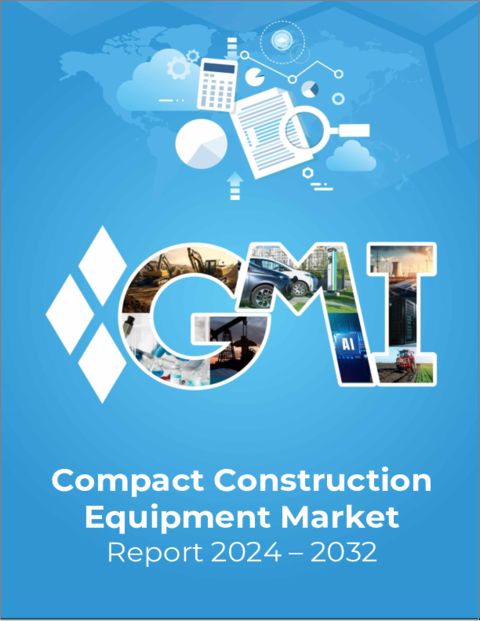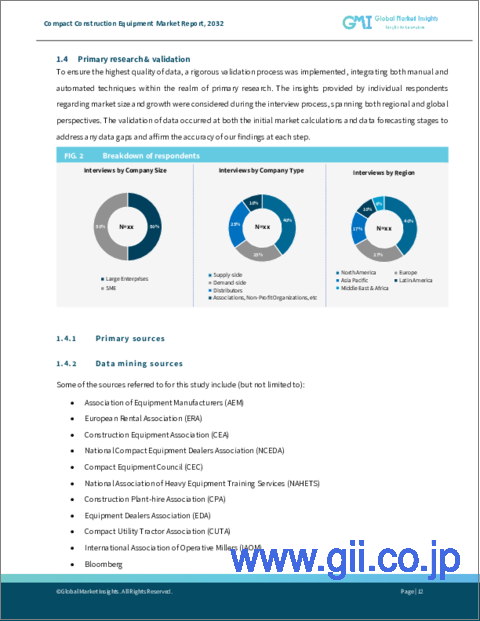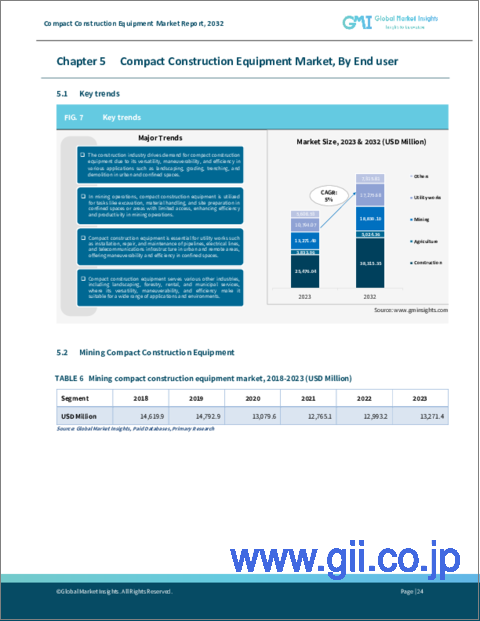|
|
市場調査レポート
商品コード
1473801
小型建設機械の市場規模:機械別、エンドユーザー別、用途別、予測、2024年~2032年Compact Construction Equipment Market Size - By Equipment , By End User, By Application & Forecast, 2024 - 2032 |
||||||
カスタマイズ可能
|
|||||||
| 小型建設機械の市場規模:機械別、エンドユーザー別、用途別、予測、2024年~2032年 |
|
出版日: 2024年02月23日
発行: Global Market Insights Inc.
ページ情報: 英文 260 Pages
納期: 2~3営業日
|
- 全表示
- 概要
- 目次
小型建設機械の市場規模は、世界の都市化率の上昇とインフラ開発プロジェクトに牽引され、2024年から2032年にかけてCAGR4%超を記録すると見られています。
都市が拡大し、スペースが限られるようになるにつれて、ミニショベル、スキッドステアローダー、コンパクトトラックローダーのような小型機器は、狭い現場を移動し、幅広い作業を効率的にこなす能力から、ますます好まれるようになっています。さらに、持続可能な建設慣行の動向の高まりが、排出ガスの削減と運転コストの低減を実現する小型電気・ハイブリッド建設機械の採用を後押ししています。
また、テレマティクス、GPS追跡、遠隔監視機能を小型建設機械に統合することで、作業効率、生産性、設備管理の強化につながっています。例えば、2022年2月、日立建機U.K.は、特に混合建設機械のフリート用に設計された新しいテレマティクス・システムを発表しました。このような技術的進歩により、請負業者や建設会社は車両の稼働率を最適化し、機器の性能を追跡し、ダウンタイムと運転コストを削減するための予防保守のスケジュールを立てることができるようになり、製品の普及が進んでいます。
業界は、機械、用途、エンドユーザー、地域によって区分されます。
機械別では、バックホーローダーセグメントの小型建設機械市場は、建設現場での様々な作業をこなす汎用性と効率性により、2032年まで勢いを増すと予想されています。バックホーローダーは、ローダーと掘削機の機能を兼ね備えており、オペレーターは掘削、ローディング、マテリアルハンドリングの作業を1台でこなすことができます。この多用途性により、バックホーローダーは、掘削や溝掘りから造園や道路整備まで、幅広い用途に欠かせない存在となっています。
エンドユーザー別では、ユーティリティインフラプロジェクトにおける多用途で操縦性の高い機器に対する需要の増加により、公共事業セグメントの小型建設機械産業規模は2024~2032年の間に大きなCAGRを記録すると予測されています。小型建設機械は、溝掘り、掘削、埋め戻し、マテリアルハンドリングなどの公共事業作業に不可欠です。これらの機械は、混雑した都市部や限られた作業現場を移動するのに必要な敏捷性と柔軟性を提供し、人口密集地での公共事業プロジェクトに不可欠なものとなっています。さらに、特に通信、水管理、配電などのインフラ整備やアップグレードが重視されるようになっていることも、製品需要の原動力となっています。
北米の小型建設機械産業は2024年から2032年にかけて大きく成長します。また、厳しい環境規制の流入や持続可能な建設手法の重視の高まりも、排出量の削減と運転コストの低減を実現する小型電気・ハイブリッド建設機械の地域的な採用を後押ししています。
目次
第1章 調査手法と調査範囲
第2章 エグゼクティブサマリー
第3章 業界洞察
- エコシステム分析
- サプライヤーの状況
- 原材料サプライヤー
- 部品サプライヤー
- 製造業者
- レンタル・プロバイダー
- エンドユーザー
- 利益率分析
- テクノロジーとイノベーションの展望
- 特許分析
- 主要ニュース&イニシアチブ
- 規制状況
- 影響要因
- 促進要因
- 建設活動の増加
- インフラ・プロジェクトへの投資の拡大
- 小型建設機械の開発における継続的な進歩
- 小型建設機械の電動化の急増
- 業界の潜在的リスク&課題
- 厳しさを増す排ガス規制
- 大型機械との激しい競合
- 促進要因
- 成長可能性分析
- ポーター分析
- PESTEL分析
第4章 競合情勢
- イントロダクション
- 企業シェア分析
- 競合のポジショニングマトリックス
- 戦略展望マトリックス
第5章 市場推定・予測:機械別、2018年~2032年
- 主要動向
- ミニショベル
- コンパクトホイールローダー
- スキッドステアローダー
- コンパクトトラックローダー
- バックホーローダー
- その他
第6章 市場推定・予測:用途別、2018年~2032年
- 主要動向
- ローディング
- 掘削
- マテリアルハンドリング
- リフティング・ホイスティング
- その他
第7章 市場推定・予測:エンドユーザー別、2018年~2032年
- 主要動向
- 建設
- 農業
- 鉱業
- 公共事業
- その他
第8章 市場推定・予測:地域別、2018年~2032年
- 主要動向
- 北米
- 米国
- カナダ
- 欧州
- 英国
- ドイツ
- フランス
- イタリア
- ロシア
- スペイン
- 北欧
- その他欧州
- アジア太平洋
- 中国
- インド
- 日本
- 韓国
- オーストラリア
- 東南アジア
- その他アジア太平洋地域
- ラテンアメリカ
- ブラジル
- メキシコ
- アルゼンチン
- その他ラテンアメリカ
- 中東・アフリカ
- アラブ首長国連邦
- 南アフリカ
- サウジアラビア
- その他中東・アフリカ
第9章 企業プロファイル
- Bobcat Company
- Caterpillar Inc.
- CNH Industrial(Case and New Holland brands)
- Deere & Company(John Deere)
- Hitachi Construction Machinery
- Hyundai Construction Equipment
- JCB(JC Bamford Excavators Ltd.)
- King Machinery
- Kobelco Construction Machinery Co., Ltd.
- Komatsu Ltd.
- Kubota Corporation
- SANY Heavy Industry Co., Ltd.
- Sumitomo Construction Machinery
- Takeuchi Manufacturing
- Terex Corporation
- Volvo Construction Equipment
- Wacker Neuson SE
- XCMG Group
- Yanmar Co., Ltd.
- Zoomlion Heavy Industry Science & Technology Co., Ltd.
Compact construction equipment market size is set to record over 4% CAGR between 2024 and 2032, driven by rising rate of urbanization and infrastructure development projects worldwide. As cities expand and space becomes limited, compact equipment like mini excavators, skid steer loaders, and compact track loaders are growing increasingly preferred for their ability to navigate tight job sites and perform a wide range of tasks efficiently. Additionally, the growing trend of sustainable construction practices is boosting the adoption of compact electric and hybrid construction equipment to offer reduced emissions and lower operating costs.
The integration of telematics, GPS tracking, and remote monitoring capabilities in compact equipment is also leading to enhanced operational efficiency, productivity, and equipment management. For example, in February 2022, Hitachi Construction Machinery U.K. unveiled a new telematics system specifically designed for fleets of mixed construction equipment. Such technological advancements are enabling contractors and construction companies to optimize fleet utilization, track equipment performance, and schedule preventive maintenance for reducing downtime and operating costs, subsequently driving the product uptake.
The industry is divided based on equipment, application, end-user and region.
In terms of equipment, the compact construction equipment market from the backhoe loaders segment is slated to gain momentum through 2032, due to their versatility and efficiency in performing various tasks on construction sites. Backhoe loaders combine the capabilities of a loader and an excavator, allowing operators to handle digging, loading, and material handling tasks with one machine. This versatility makes backhoe loaders indispensable for a wide range of applications, from excavation and trenching to landscaping and road maintenance.
By end-user, the compact construction equipment industry size from the utility works segment is anticipated to observe a significant CAGR during 2024-2032, favored by the increasing demand for versatile and maneuverable equipment in utility infrastructure projects. Compact construction equipment are essential for utility works tasks, such as trenching, digging, backfilling, and material handling. These machines offer the agility and flexibility required to navigate congested urban areas and confined worksites, emerging indispensable for utility projects in densely populated areas. Additionally, the growing emphasis on infrastructure development and upgrades, particularly in telecommunications, water management, and electricity distribution is driving the product demand.
North America compact construction equipment industry will grow substantially between 2024 and 2032, attributed to the robust infrastructure development projects across various sectors, including residential, commercial, and industrial. The influx of stringent environmental regulations and the growing emphasis on sustainable construction practices are also propelling the regional adoption of compact electric and hybrid construction equipment to offer reduced emissions and lower operating costs.
Table of Contents
Chapter 1 Methodology & Scope
- 1.1 Market scope & definition
- 1.2 Base estimates & calculations
- 1.3 Forecast calculation
- 1.4 Data sources
- 1.4.1 Primary
- 1.4.2 Secondary
- 1.4.2.1 Paid sources
- 1.4.2.2 Public sources
Chapter 2 Executive Summary
- 2.1 Industry 360 degree synopsis, 2018 - 2032
Chapter 3 Industry Insights
- 3.1 Industry ecosystem analysis
- 3.2 Supplier landscape
- 3.2.1 Raw material suppliers
- 3.2.2 Component suppliers
- 3.2.3 Manufacturers
- 3.2.4 Rental providers
- 3.2.5 End-users
- 3.3 Profit margin analysis
- 3.4 Technology & innovation landscape
- 3.5 Patent analysis
- 3.6 Key news & initiatives
- 3.7 Regulatory landscape
- 3.8 Impact forces
- 3.8.1 Growth drivers
- 3.8.1.1 Rise in construction activities
- 3.8.1.2 Growing investments in infrastructure projects
- 3.8.1.3 Continuous advancements in the development of compact equipment
- 3.8.1.4 Surging electrification of compact construction equipment
- 3.8.2 Industry pitfalls & challenges
- 3.8.2.1 Increasingly stringent emission regulations
- 3.8.2.2 Intense competition from larger equipment
- 3.8.1 Growth drivers
- 3.9 Growth potential analysis
- 3.10 Porter's analysis
- 3.10.1 Supplier power
- 3.10.2 Buyer power
- 3.10.3 Threat of new entrants
- 3.10.4 Threat of substitutes
- 3.10.5 Industry rivalry
- 3.11 PESTEL analysis
Chapter 4 Competitive Landscape, 2023
- 4.1 Introduction
- 4.2 Company market share analysis
- 4.3 Competitive positioning matrix
- 4.4 Strategic outlook matrix
Chapter 5 Market Estimates & Forecast, By Equipment 2018 - 2032 ($Bn, Units)
- 5.1 Key trends
- 5.2 Mini excavators
- 5.3 Compact wheel loaders
- 5.4 Skid steer loaders
- 5.5 Compact track loaders
- 5.6 Backhoe loaders
- 5.7 Others
Chapter 6 Market Estimates & Forecast, By Application, 2018 - 2032 ($Bn, Units)
- 6.1 Key trends
- 6.2 Loading
- 6.3 Excavation
- 6.4 Materials handling
- 6.5 Lifting & hoisting
- 6.6 Others
Chapter 7 Market Estimates & Forecast, By End-User, 2018 - 2032 ($Bn, Units)
- 7.1 Key trends
- 7.2 Construction
- 7.3 Agriculture
- 7.4 Mining
- 7.5 Utility works
- 7.6 Others
Chapter 8 Market Estimates & Forecast, By Region, 2018 - 2032 ($Bn, Units)
- 8.1 Key trends
- 8.2 North America
- 8.2.1 U.S.
- 8.2.2 Canada
- 8.3 Europe
- 8.3.1 UK
- 8.3.2 Germany
- 8.3.3 France
- 8.3.4 Italy
- 8.3.5 Russia
- 8.3.6 Spain
- 8.3.7 Nordics
- 8.3.8 Rest of Europe
- 8.4 Asia Pacific
- 8.4.1 China
- 8.4.2 India
- 8.4.3 Japan
- 8.4.4 South Korea
- 8.4.5 Australia
- 8.4.6 Southeast Asia
- 8.4.7 Rest of Asia Pacific
- 8.5 Latin America
- 8.5.1 Brazil
- 8.5.2 Mexico
- 8.5.3 Argentina
- 8.5.4 Rest of Latin America
- 8.6 MEA
- 8.6.1 UAE
- 8.6.2 South Africa
- 8.6.3 Saudi Arabia
- 8.6.4 Rest of MEA
Chapter 9 Company Profiles
- 9.1 Bobcat Company
- 9.2 Caterpillar Inc.
- 9.3 CNH Industrial (Case and New Holland brands)
- 9.4 Deere & Company (John Deere)
- 9.5 Hitachi Construction Machinery
- 9.6 Hyundai Construction Equipment
- 9.7 JCB (JC Bamford Excavators Ltd.)
- 9.8 King Machinery
- 9.9 Kobelco Construction Machinery Co., Ltd.
- 9.10 Komatsu Ltd.
- 9.11 Kubota Corporation
- 9.12 SANY Heavy Industry Co., Ltd.
- 9.13 Sumitomo Construction Machinery
- 9.14 Takeuchi Manufacturing
- 9.15 Terex Corporation
- 9.16 Volvo Construction Equipment
- 9.17 Wacker Neuson SE
- 9.18 XCMG Group
- 9.19 Yanmar Co., Ltd.
- 9.20 Zoomlion Heavy Industry Science & Technology Co., Ltd.





